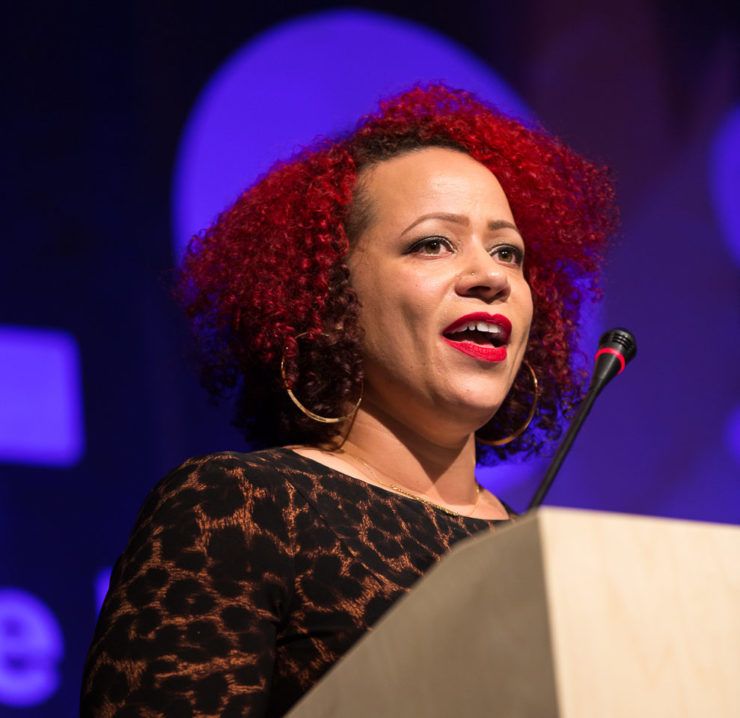
Counter demonstrators holding a banner decrying white supremacists Charlottesville, Va., in August.
These words from journalist Nikole Hannah-Jones sum up this week’s posts on racism and white supremacism better than I ever could: “The truth is even though this is fundamental and foundational to living in the United States, this is a history and a truth that most Americans are in denial about. It’s a history that is very hard to bear and admit when you believe that your country is an exceptional beacon of freedom and democracy in the world, yet you are founded on the forced bondage of millions of people.”

Elle Reeve with white nationalist Christopher Cantwell during the "Unite the Right" rally in Charlottesville in August
Vice News correspondent Elle Reeve and “Charlottesville: Race and Terror.” At a fascinating “Lippman Live” event at the Nieman Foundation HQ in Cambridge, Reeve talked to Nieman Fellow Jamieson Lesko about the viral documentary that woke a lot of people up about white supremacism in America. The two of them “annotated” clips from the chilling doc, with Reeve giving us the back story on the incredible footage. Reeve said: “I’ve been covering this for a while. Every time I would, my friends would say: ‘Well, they don’t really mean it, though, right? I mean, there’s not that many of them.’ I feel like that’s denial. I think it is very dangerous to ignore this. So that is one reason I am very happy with the final product, because it made people wake up to it.”
The soundtrack: “Fear of a Black Planet,” by Public Enemy. “What is pure/who is pure?/Is it European?/I’m not sure.” It’s depressing that this song could have been written today, nearly 30 years after it was written. The album of the same name is brilliant — revolutionary, even.
One Great Sentence
“Along with these tots and second-honeymooners, there were Harvard freshmen, giving off that peculiar nervous glow created when a quantity of insouciance is saturated with insecurity; thick-necked Army officers with brass on their shoulders and lead in their voices; pepperings of priests; perfumed bouquets of Roxbury Fabian fans; shiny salesmen from Albany and Fall River; and those gray, hoarse men—taxi-drivers, slaughterers, and bartenders who will continue to click through the turnstiles long after everyone else has deserted to television and tramporamas.”
John Updike, “Hub Fans Bid Kid Adieu,” The New Yorker, October 22, 1960. Read why we think it’s great.

Nikole Hannah-Jones talks at the Power of Storytelling conference in Bucharest, Romania, last year.
Nikole Hannah-Jones on reporting about racial inequality: “What drives me is rage.” At the annual Power of Storytelling conference in Romania last weekend, the New York Times Magazine writer rejected the idea that journalists can be objective observers. “I’m not, and none of us are,” she said. “What drives me is rage. Because I think what we’re doing to children is wrong, and I’m not going to pretend to be objective about it. I think it’s hypocritical and I think that it’s wrong. I got into journalism because I feel like we have to do better and if we’re not going to do better, I’m not going to let us sit comfortably and pretend that everything is OK.” She had this great line about narrative journalism and subjects like entrenched racism: “Our job as storytellers – if we want to get people to care about things that seem to be fixed in our country – is we have to figure out a way to make them see the story in a different way and to help them understand they actually don’t know the story at all.”
The soundtrack: “Power to the People,” by Public Enemy. I thought I’d stick with the “Fear of a Black Planet” album for this post too; the lyrics fit Nikole Hannah-Jones’ decision to become a journalist back in high school. “Power to the people/Get on up, get into it, get involved.”
What I’m reading online: “The Body Trade: Cashing in on the Donated Dead,” by Brian Grow and John Shiffman. This Reuters series about the trade in body parts will disturb you even as it moves you — especially if you plan to donate your body to science or have a loved one who already has. This installment, about a 24-year-old boy with disabilities, broke my heart. His parents couldn’t afford cremation, so they thought they would help someone else and donate his body. Instead, his body parts were sold — including, to a Reuters reporter, his spine. His mother’s despair that her boy was cut up once again after a lifetime of surgeries will stay with me for a long time.
“The Yahoo With the Microphone,” by Martin Amis. This falls into the category of “I’ll read just about anything Martin Amis has to write,” even if it’s the umpteenth story about Donald Trump’s America. Here’s a great line from the beginning of the Esquire piece: “On the way, I silently rehearsed the Barry Manilow Law, as promulgated by the poet-critic Clive James: Everyone you know thinks Barry Manilow is absolutely terrible; but everyone you don’t know thinks he’s great.”
“Inside the Mind of Thru-Hiking’s Most Devious Con Man,” by Brendan Borrell. The con-man genre has gotten a bit tired, but I liked the angle of this one in the always-reliable Outside magazine: “I wondered if there was something about the outdoor community and our sympathy for such wanderers that may make us especially easy marks,” Borrell writes. “When we see a man with a trail-worn Gore-Tex jacket and a decade-old Dana Designs backpack, we instinctively trust him. We can’t help but envy his authenticity, his freedom. He’s not just a weekend warrior—he’s living the life we want. ”
 What’s on my bedside table: “Second Person Rural,” by Noel Perrin. As someone who moved from the city to the country, I perhaps understandably have a whole collection of books of this genre. My favorite is “We Took to the Woods,” by Louise Dickinson Rich, but Noel Perrin comes close. His books are also set in New England — Vermont instead of Maine — and he has a lovely touch in describing both the beauty of his adopted home and the conflicts (and, usually, resolutions) between newcomers and locals.
What’s on my bedside table: “Second Person Rural,” by Noel Perrin. As someone who moved from the city to the country, I perhaps understandably have a whole collection of books of this genre. My favorite is “We Took to the Woods,” by Louise Dickinson Rich, but Noel Perrin comes close. His books are also set in New England — Vermont instead of Maine — and he has a lovely touch in describing both the beauty of his adopted home and the conflicts (and, usually, resolutions) between newcomers and locals.
 What’s on my turntable: “Facts of Life,” by Bobby Womack. This album (which has one of the worst illustrations in album coverdom) may not have his sublime “Across 110th Street,” but it’s still wonderful. I love the raps he does before some of the songs. And wow, I had no idea that the first song on the album, “Nobody Knows You When You’re Down and Out,” was written in the 1920s, in the boom times before the Great Depression.
What’s on my turntable: “Facts of Life,” by Bobby Womack. This album (which has one of the worst illustrations in album coverdom) may not have his sublime “Across 110th Street,” but it’s still wonderful. I love the raps he does before some of the songs. And wow, I had no idea that the first song on the album, “Nobody Knows You When You’re Down and Out,” was written in the 1920s, in the boom times before the Great Depression.
If you want to chat about storytelling (or music), I’m Storyboard editor Kari Howard, and you can reach me at editor@niemanstoryboard.org. Or you can find me at @karihow on Twitter.


